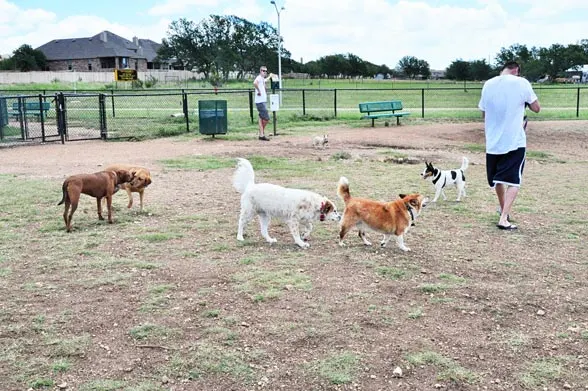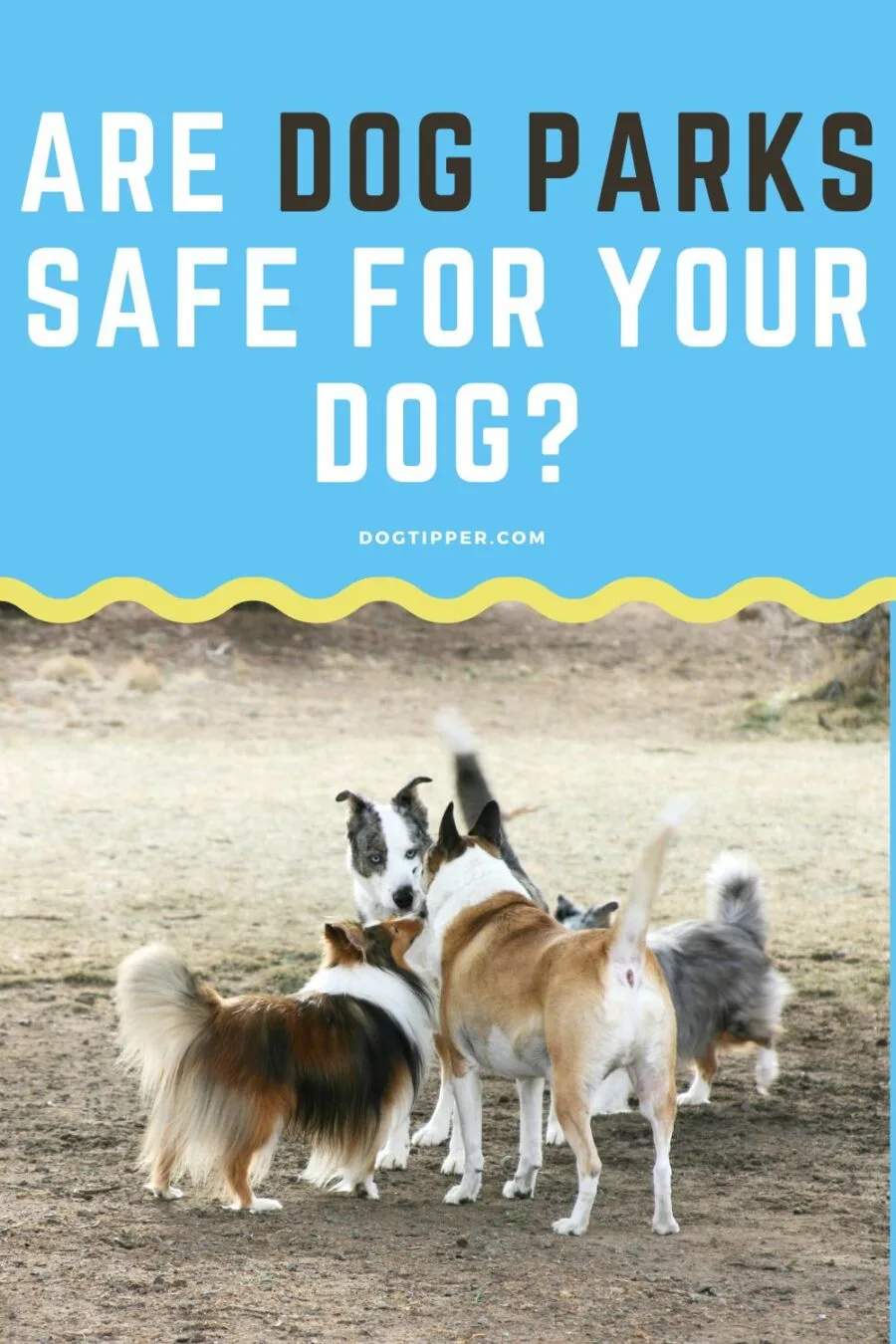Dog parks are a popular way to socialize your dog and to burn off some of that doggie energy, helping to avoid behavioral problems like chewing, digging, and barking. But, as much fun as your local dog park might be for you and your dog, dog park safety has to be a priority.
If you’ve visited dog parks, you’ve no doubt seen some bad practices. People on the cell phones, oblivious to what’s going on around them. Children in the dog parks. People with food and drink in the dog parks. All dog park safety no-nos.
And we’ve all heard (or seen!) the horror stories of dogs who get into fights at dog parks–and pet deaths have occurred, especially when small dogs or puppies play in the large dog area (or large dogs are allowed to go into the small dog section).
And illness is another risk as dogs get sick from other dogs–and dog waste–at the park.
How can you keep your dog safe at a dog park? We’ve got expert tips on dog park safety so you and your dog can enjoy your visit.

Is Your Dog Right for a Dog Park?
Even if you plan to follow all the rules and take safety precautions, your first question has to be “is my dog right for a dog park?”
Not every dog is dog park material. And that’s OK!
We’ve visited dog parks all around Texas as we researched our Texas with Dogs guidebook–and Tiki loved dog parks. She loved meeting new dogs and new people. Irie, however, did not. We quickly saw after a couple of visits that she just felt ill at ease–like a shy person at a large party.
Now, with Barli and Isla, we know that we have the same mix. (We always adopt one outgoing and one shy dog.)
Isla loves new experiences, new people, new dogs. Barli likes to hang out with us and Isla, only going up to new people after they’ve gotten Isla’s seal of approval. He doesn’t like strange dogs running up to him off leash and obviously feels uncomfortable.
And he’s not alone. Many dogs don’t like dog parks, even if their pet parents love the idea.
The alternative? We socialize our dogs in small groups. They get to play with our neighbors’ dogs that they know and trust. They get out and meet new people (and sometimes new dogs, one at a time and on leash) at patio restaurants and dog-friendly shops or on hiking trails and in parks.
Most Common Dog Park Injuries

Failure to really watch dogs (or taking dogs who just don’t feel comfortable in a dog park) and failure to obey the rules means dog park injuries–and a lot of them.
Nationwide pet insurance released a list of the most common claims they see related to dog park injuries–and noted that in a single year, Nationwide members spent more than $10 million on medical conditions that are commonly associated with dog park fun.
Just what were those most common injuries and medical conditions?
| Most Common Dog Park-Related Medical Conditions | |
| Injury | Cost |
| Sprains & Soft Tissue Injuries | $225 |
| Lacerations or Bite Wounds | $361 |
| Kennel Cough or Upper Respiratory Infection | $174 |
| Insect Bites | $143 |
| Head Trauma | $591 |
| Hyperthermia or Heat Stroke | $579 |
The most common medical condition on the list was soft tissue injuries or sprains, which affected nearly 24,000 Nationwide insured dogs last year. Head trauma from dogs crashing into objects or one another accounted for the most expensive condition on the list with an average cost of $591 per dog.
“The dog park is a great place for dogs to socialize and exercise, but there are safety measures dog owners need to be aware of,” said Carol McConnell, DVM, MBA, vice president and chief veterinary medical officer for Nationwide.
“Many of the medical conditions on our dog park related injury list can be avoided by taking necessary precautions, but some are out of the owner’s control. If any of these issues occur, dog owners should take their companion to their veterinarian immediately for treatment.”
Making Your Visit Safer

Of course, no visit anywhere (even your own backyard!) is 100 percent safe but there are definitely some steps you can take to make your next dog park visit safer.
Nationwide recommends that everyone at the dog park:
- Obey all posted rules and regulations.
- Pay attention to your dog at all times and ensure that playtime remains friendly. If your dog or another dog is playing too rough, it’s best to remove your dog from the situation.
- Many dog parks have designated areas for large and small dogs. No matter your dog’s stature, be sure to keep them in the area allocated for their size.
- Don’t bring a puppy younger than four months old.
- Make sure your dog is up to date on vaccinations.
- Keep a collar on your dog with proper identification tags that include contact information (microchipping is also recommended).
- On warm days, avoid the dog park during peak temperature hours.
- Bring water and a bowl for your dog to drink out of.
- Look for signs of overheating; including profuse and rapid panting, a bright red tongue, thick drooling saliva, glassy eyes and lack of coordination. If this occurs, take your dog to a veterinarian immediately.

What Tips Do Veterinarians Give About Dog Parks?
Nationwide said it but it bears saying again–and the California Veterinary Medical Association (CVMA) says it: “Keep your dog’s vaccinations current. Other dogs may not be up-to-date on vaccinations, and your dog could be exposed to diseases.”
You can’t control whether or not other people have vaccinated their dogs–but you can control the vaccination status of your own dog.
The CVMA has these other tips for keeping your pet safe when visiting dog parks:
- Bring water for your dog to drink. Water stations at the park have been used by other dogs and wildlife and may be a source of disease. (I love this tip–I carry water for our dogs any time we go to a public place and never let them drink out of communal bowls. I wouldn’t want to share a glass with everyone at the park, right?!)
- Clean your dog’s paws when you leave the park to minimize the risk of parasites or diseases from the soil.
- Have your veterinarian check your dog regularly for parasites.
- Talk to your veterinarian about any precautions you should take with your dog.
- Socialize your dog − to other dogs and people − before going to dog parks.
- Keep an eye on your dog to prevent it from getting into fights.
- Small dogs should go to dog parks that have separate areas for smaller breeds. Untrained larger dogs may perceive them as prey or engage in rough play.
- Follow the dog park rules. They generally include licensing requirements, leash laws and a minimum-age requirement for children.
And, especially, in these litigious days…do not forget “you are personally and legally responsible for your dog.“
Yes, let that sink in. If your dog injures another dog (or if someone thinks it was your dog that injured another dog–sometimes it can be hard to tell) or if your dog injures a person, YOU are legally responsible.
In conclusion, if you are going to take your dog to a dog park then prioritizing dog park safety is crucial for both the well-being of your dog and the overall enjoyment of your visit. By following a few simple guidelines, making sure your dog is a good fit for a dog park and taking proactive measures, you can create a safer environment for your dog.
You Also Might Like These Posts
Dog Park Time—Some Simple Dos and Don’ts
Ask Alecia: My Dog Attacked a Dog at the Dog Park!
Purina Pet Haven Opens as Manhattan’s 1st Domestic Violence Shelter Dog Park
Creating Your Own At-Home Dog Park
Dream Dog Park Unveiled in Alabaster, Alabama
Pin it to remember

- Review: Jimmy BX7 Pro Anti-Mite Vacuum Cleaner - December 16, 2024
- 🎉 GIVEAWAY: Lord of the Pets Portrait of Your Dog! - November 26, 2024
- Review: Lord of the Pets Portraits - November 17, 2024
